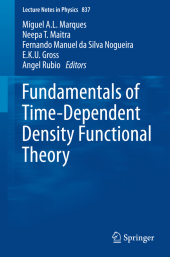 Neuerscheinungen 2012Stand: 2020-01-07 |
Schnellsuche
ISBN/Stichwort/Autor
|
Herderstraße 10
10625 Berlin
Tel.: 030 315 714 16
Fax 030 315 714 14
info@buchspektrum.de |

E. K. U. Gross, Neepa T. Maitra, Miguel A.L. Marques, Fernando Manuel da S Nogueira, Angel Rubio
(Beteiligte)
Fundamentals of Time-Dependent Density Functional Theory
Herausgegeben von Marques, Miguel A.L.; Maitra, Neepa T.; Nogueira, Fernando Manuel da Silva; Gross, E.K.U.; Rubio, Angel
2012. 2012. xxxii, 559 S. 72 SW-Abb. 235 mm
Verlag/Jahr: SPRINGER, BERLIN 2012
ISBN: 3-642-23517-4 (3642235174)
Neue ISBN: 978-3-642-23517-7 (9783642235177)
Preis und Lieferzeit: Bitte klicken
There have been many significant advances in time-dependent density functional theory over recent years, both in enlightening the fundamental theoretical basis of the theory, as well as in computational algorithms and applications. This book, as successor to the highly successful volume Time-Dependent Density Functional Theory (Lect. Notes Phys. 706, 2006) brings together for the first time all recent developments in a systematic and coherent way.
First, a thorough pedagogical presentation of the fundamental theory is given, clarifying aspects of the original proofs and theorems, as well as presenting fresh developments that extend the theory into new realms-such as alternative proofs of the original Runge-Gross theorem, open quantum systems, and dispersion forces to name but a few. Next, all of the basic concepts are introduced sequentially and building in complexity, eventually reaching the level of open problems of interest. Contemporary applications of the theory are discussed, from real-time coupled-electron-ion dynamics, to excited-state dynamics and molecular transport. Last but not least, the authors introduce and review recent advances in computational implementation, including massively parallel architectures and graphical processing units. Special care has been taken in editing this volume as a multi-author textbook, following a coherent line of thought, and making all the relevant connections between chapters and concepts consistent throughout. As such it will prove to be the text of reference in this field, both for beginners as well as expert researchers and lecturers teaching advanced quantum mechanical methods to model complex physical systems, from molecules to nanostructures, from biocomplexes to surfaces, solids and liquids.
From the reviews of LNP 706:
"This is a well structured text, with a common set of notations and a single comprehensive and up-to-date list of references, rather than just a compilation of research articles. Because of its clear organization, the book can be used by novices (basic knowledge of ground-state DFT is assumed) and experienced users of TD-DFT, as well as developers in the field." (Anna I. Krylov, Journal of the American Chemical Society, Vol. 129 (21), 2007)
"This book is a treasure of knowledge and I highly recommend it. Although it is a compilation of chapters written by many different leading researchers involved in development and application of TDDFT, the contributors have taken great care to make sure the book is pedagogically sound and the chapters complement each other [...]. It is highly accessible to any graduate student of chemistry or physics with a solid grounding in many-particle quantum mechanics, wishing to understand both the fundamental theory as well as the exponentially growing number of applications. [...] In any case, no matter what your background is, it is a must-read and an excellent reference to have on your shelf."
Amazon.com, October 15, 2008, David Tempel (Cambridge, MA)
Part I Theory and Experiment - Why We Need TDDFT.- Part II Basic Theory.- PartIII Advanced Concepts.- Part IV Real-Time Dynamics.- Part V Numerical Aspects.- Part VI TDDFT vs Other Theoretical Techniques.


